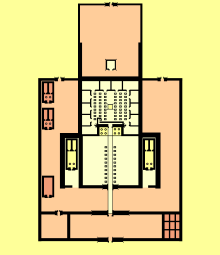Gem-pa-Aton (Karnak)
The Gem-pa-Aton (transcription: Gm-p3-Jtn , translation for example: "Found is the Aton") is a district of the Karnak Temple , which was built by Pharaoh Akhenaten in honor of the sun god Aton . Akhenaten saw in Aton the only god to be worshiped and thus caused the displacement of the other gods and the closure of temple complexes, including that of the Amun temple . The conditions at that time are often referred to as a revolution in Egyptological circles . After the original conditions were restored after Akhenaten's death, the Gem-pa-Aton was completely demolished.
Location and building
The Gem-pa-Aton was located east of the Amun district and was 130 meters wide and an estimated length of 200 meters. The complex possibly consisted of a large courtyard, which was divided into several parts by transverse walls. The halls were, according to Arnold , surrounded by 5 m high statue pillars, which showed the misleading genderless or bisexual appearance of the king. In other monuments the rudschi-menu njten , the teni-menu and the Benben house are mentioned. These are also all destroyed, there are different theories about their content. It is often emphasized that the new temple of Akhenaten was larger than the conventional temple in Karnak; Here, however, it must be taken into account that a large part of the Amun temple was only built in the Ramessidic period .
The destruction of the temple

After the end of the Akhenaten government, the facility was completely torn down and the blocks called talatat were used as filler material in other structures. Paradoxically, it was precisely through this use that they were protected from the elements. During restoration work on the Amun Temple, tens of thousands of the Talatat blocks came to light completely incoherently, but in good condition and with considerable paint residues. They had been reused in the buildings of Haremhab and his successors.
Many of the talatat blocks were found in Haremhab's pylons , giving rise to the assumption that the damnation of the memory was initiated by him. In fact, a multiple of the actions will only pass to Ramses I and his son Seti I return. Nevertheless, Haremhab tried to destroy the memory of the Amarna kings and appears in the Egyptian king lists directly after Amenophis III. In Luxor Museum a few hundred of these blocks are restored and put back together.
See also
literature
- Dieter Arnold : Lexicon of Egyptian architecture. Bibliographisches Institut, Mannheim 2000, ISBN 3-491-96001-0 , p. 30.
- Dieter Arnold: The temples of Egypt. Apartments for gods, monuments, places of worship. Artemis & Winkler, Zurich 1992, ISBN 3-86047-215-1 , pp. 126-27.
- Erik Hornung : Akhenaten: the religion of light. Artemis, Munich / Zurich 1995, ISBN 3-7608-1111-6 .
- Donald B. Redford : Karnak, Akhenaten temples. In: Kathryn A. Bard (Ed.): Encyclopedia of the Archeology of Ancient Egypt. Routledge, London 1999, ISBN 0-415-18589-0 , pp. 391-94.
Web links
Individual evidence
- ^ Dieter Arnold: Lexicon of Egyptian architecture. Albatros, Düsseldorf 2000, ISBN 3-491-96001-0 .
- ↑ Dieter Arnold: The temples of Egypt. Apartments for gods, monuments, places of worship. Zurich 1992, p. 126f.
